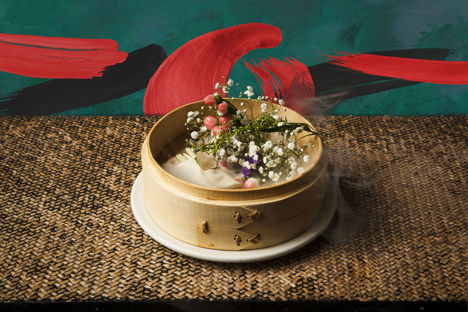
Painting a picture: 'Plum in a Golden Vase'
Mukta Das and Andrew Wong explore the traditions of vegetarian ‘mock’ meat in Chinese Buddhist cooking, before creating a recipe inspired by a novel written during the Ming Dynasty in which a concubine cannot believe the food she’s eating is vegetarian.
Painting a picture: 'Plum in a Golden Vase'
Mukta Das and Andrew Wong explore the traditions of vegetarian ‘mock’ meat in Chinese Buddhist cooking, before creating a recipe inspired by a novel written during the Ming Dynasty in which a concubine cannot believe the food she’s eating is vegetarian.
While ‘alternative meats’ and bleeding veggie burgers are all the rage right now, the idea of making vegetarian food look, act and taste like meat has existed in China for 1,500 years. Food anthropologist Mukta Das and Michelin-starred chef Andrew Wong have worked together to research this style of cooking, developing a recipe which pays homage to the vegetarian Buddhist cuisine of China. Read on for an idea of how they came up with the dish (which is centred around a little-known Chinese cheese from Guangdong that’s similar to mozzarella) before taking a look at the recipe.
Anon. The Plum in a Golden Vase Vol. 2, translated from Chinese by David Tod Roy, 1993, Princeton University Press. p 432.
Andrew Wong: This dish is named after an erotic novel called Plum in a Golden Vase written in the Ming Dynasty about three powerful women in an elite household. In the book one of the women dines at what turns out to be a Buddhist monastery’s kitchen and she turns away the food because she's a vegetarian. The Buddhists explain that what they’re serving is actually mock meat and she refuses to believe it. That's the inspiration behind the dish – the fact that a lifelong vegetarian is so impressed (or horrified!) by how good these Buddhist monks are at faking meat. It started off with a conversation between Mukta and I about Buddhist cuisine, and the monks who could create vegetarian food that looked and tasted like meat. This style of cooking has a huge amount of relevance in 2019 with the rise of veganism and ‘fake’ meats – there are vegetarians who want vegetarian food that has no reminiscence of meat at all, and there are people who want vegetarian meat to bleed. These Buddhist temple chefs found a middle ground.
Mukta Das: Rather than ask Chinese Buddhists to abstain from meat forever, monks proclaimed it was fine to be vegetarian only on certain days (such as festivals, birthdays and death days). On these days, temples were on hand to serve vegetarian food. It was a fitting compromise for a country of meat lovers (although it wasn’t actually eaten that often, as meat was – and still is – expensive). A lot of these Buddhist temple kitchens were set up to serve and develop this style of food; a little like the contemporary meat substitute labs of today. They had to find an aesthetic for their meat-free dishes whilst keeping them appropriately holy, but could still satisfy the palates of meat eaters.
The woman in Plum in a Golden Vase clearly found herself eating something very meaty in terms of texture and flavour, and (to paraphrase) she's says, ‘Wait a minute, this is meat. I told you, I'm a bit morally bankrupt, I need to have vegetarian food.’ And the Buddhists were like, ‘No, Aunty, calm yourself, this is definitely, definitely a meat substitute.’ So we were thinking about the aesthetics of what she would have been presented, perhaps with a bite, a smoky umami flavour and maybe even a farmy quality, and looked at certain ways to represent this passage in its full glory.
AW: Going back to the title of the book Plum in a Golden Vase, I experimented and found a filata (stretched-curd) cheese with the right kind of bite and seasoned it with a char siu marinade to give it a meaty look and flavour. The ‘golden vase’ element is represented by encasing the cheese in deep-fried pastry. You might be thinking ‘why is there cheese in a Chinese recipe?’, but Mukta knew that in Guangdong there are a lot of water buffalos, so there’s actually been a buffalo cheese industry in the area for a long time. They manipulate the curd in a way that stretches it, pressing it against the side of hot porcelain bowls – a technique that reflects mozzarella production. When farmers have animals that produce a lot of milk, they're going to make cheese as it adds value to their labour. It doesn't matter if it's in Greece, Cyprus, Italy or China.
MD: The same goes for deep-frying. It’s a cooking technique that likely became popular by the time of the Ming Dynasty, as it was a particularly useful way for Buddhist monk-chefs to heighten the meatiness of tofu.
AW: It’s important to remember that Buddhism isn't Chinese, too. Buddhism established itself in China sometime between 1AD and 100AD from India, coming across the desert roads of western and central China. Along these roads – what we now know as Silk Roads – Buddhist monasteries were built and, by the fourth century, there were quite a few. People often think of Buddhist cuisine as a vegetarian thing, but Mukta tells me that back then some chefs were not above adding a bit of meat stock to help their cause! The story about the woman eating mock meat and the fact that there are ingredients like stretched-curd cheeses in China shows that the absolutes and assumptions we make about Chinese cuisine are often wrong.


